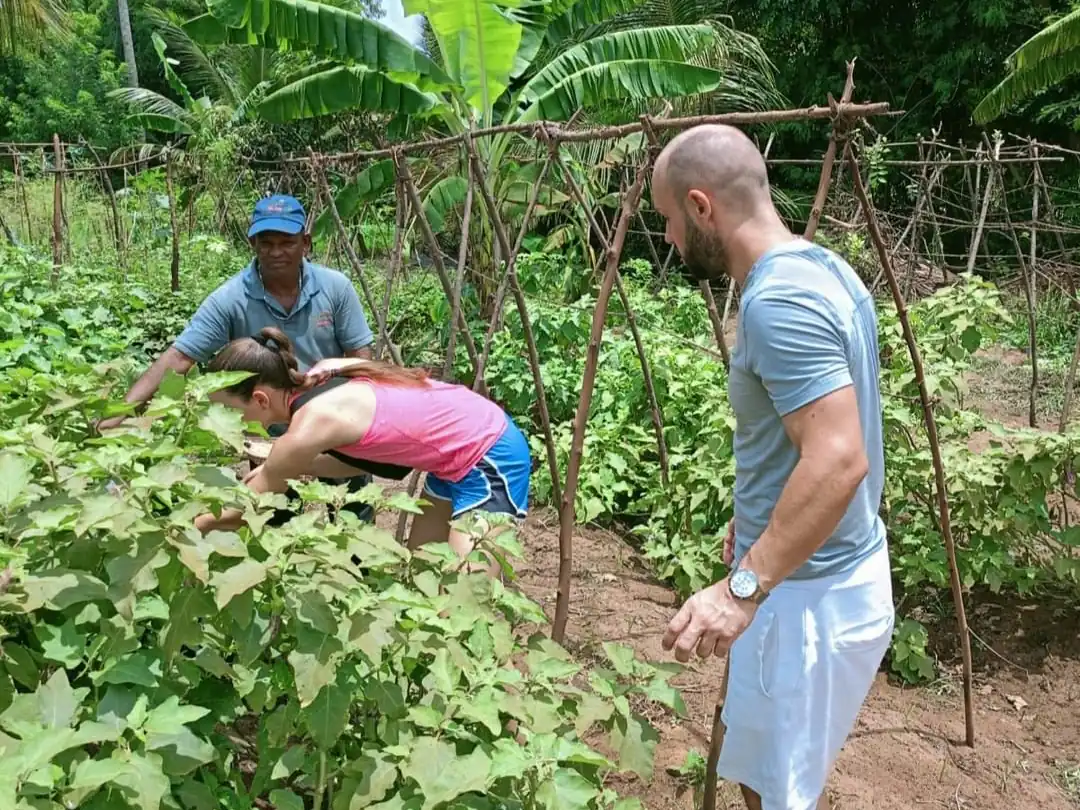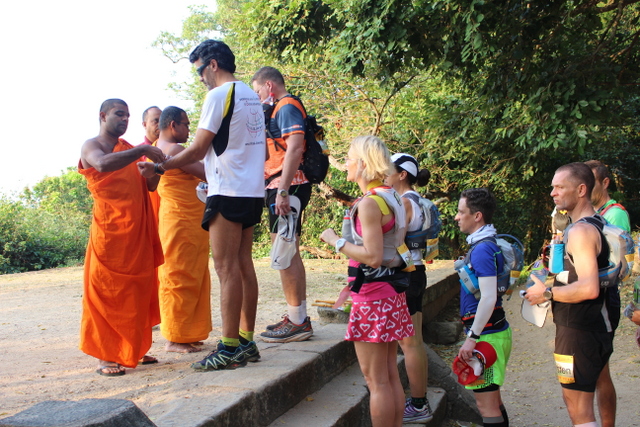
Photo from Jetwing Beach
What Is Sustainable Tourism and Why Does It Matter? Well, tourism isn’t just about booking flights, taking selfies with famous landmarks, and enjoying sunsets on tropical beaches; it’s so much more. As the world opens up to more travelers every year, we must ask ourselves: how do we ensure tourism doesn’t harm the places we love to visit? This is where sustainable tourism steps in.
Sustainable tourism is all about traveling to minimize the bad stuff (like environmental damage and overcrowding) while boosting the good (like supporting local economies and protecting natural resources).
It’s about making sure that the money we spend on vacations doesn’t just disappear into corporate pockets but stays within local communities, helping them thrive. So, in this article, I’m going to explain how Sustainable Tourism in Negombo works and whether it actually matters.
What Is Sustainable Tourism and Why Does It Matter?

A tourist proudly holds up a freshly caught fish in Negombo, Sri Lanka.- myceylonadventures.com
Sustainable tourism is about understanding both the good and the bad that come with travel. When done right, tourism can uplift communities, boost local economies, and shine a spotlight on incredible natural wonders.
But unchecked, it can just as easily lead to environmental damage, overcrowding, and a draining of local resources. Sustainable tourism aims to minimize issues like economic leakage (when tourism revenue leaves a country without benefiting locals), reduce environmental harm, and avoid the crush of over-tourism that often wrecks destinations.
The goal is to protect and help these places. It’s about ensuring that while we enjoy our adventures, we also respect the cultures, ecosystems, and people who make those experiences possible. The easiest way to understand sustainable tourism is to understand its core concepts.
5 P’s of Sustainable Tourism
According to the United Nations, the “5 P’s” framework consists of the five core elements that will lead us toward sustainable development by 2030.
- People: It all starts with people. Tourism should enrich lives, not disrupt them.
- Plants: The natural environment is key. Think of the jungles, mountains, oceans, and wildlife that make travel so exciting.
- Poverty: Tourism can be a powerful tool to help alleviate poverty. I
- Prosperity: Beyond economic benefits, sustainable tourism focuses on creating lasting prosperity for both visitors and hits.
- Peace: Tourism has the potential to foster peace by promoting understanding between different cultures.
Together, these five pillars ensure that today meets today’s needs and lays the groundwork for a better tomorrow.

Sustainable tourism balances its benefits and challenges, uplifting communities and preserving natural wonders. – AFP pic
4 Pillars of Sustainable Tourism
If you really want to understand sustainable tourism a little bit better, you need to know its four main pillars.
- Environmental Responsibility: This is all about safeguarding the planet. Sustainable tourism works to reduce carbon footprints, conserve water, protect wildlife, and ensure that tourism leaves as little damage as possible.
- Social Equity: Travel should be inclusive. This pillar emphasizes that tourism should be fair and accessible to everyone, with special attention to ensuring that host communities aren’t left behind.
- Economic Health: Tourism is big business, but how sustainable is it? This pillar looks at how tourism can contribute to the financial well-being of a destination.
- Cultural Vitality The world’s cultures are what make travel so fascinating. This pillar focuses on protecting and promoting local traditions, languages, and arts.
ILO’s Definition of Sustainable Tourism
The International Labour Organization (ILO) takes a slightly different, more focused approach when defining sustainable tourism. According to the ILO, the core of sustainable tourism lies in three essential pillars:
- Social Justice: Tourism should promote fairness. This means ensuring that workers are treated right, local businesses thrive, and communities are empowered rather than exploited.
- Economic Development: Tourism has the potential to drive economic growth, especially in developing countries.
- Environmental Integrity: No matter how good tourism is for people or the economy won’t won’t mean much if it destroys the environment.
Global Role of Sustainable Tourism
Sustainable tourism plays a crucial role on the global stage, serving as a bridge between economic development and environmental protection. At first glance, tourism might seem like it’s all about leisure and exploration, but it’s actually one of the most important contributors to the global economy.
The United Nations (UN) recognizes how important sustainable tourism is, linking it directly to several of its Sustainable Development Goals (SDGs). These include promoting economic growth, creating decent employment, and ensuring sustainable production and consumption. But it doesn’t stop there. Sustainable tourism is also deeply tied to environmental efforts like ocean conservation and the sustainable use of natural resources.
Sustainable Development and Tourism
Sustainable tourism is like walking a tightrope, balancing economic, social, and environmental factors simultaneously. It’s not easy, but it’s necessary.
The concept of sustainable development has been part of global conversations since the 1992 Rio Earth Summit, which laid the groundwork for many of the sustainability frameworks we see today. Sustainable tourism is one of the key ways to achieve the goals outlined in that summit.
The Sustainable Development Goals (SDGs) offer a clear roadmap, aiming to not only boost the economy but also promote social development and environmental protection.
Sri Lanka’s Approach to Sustainable Development

Sri Lanka’s approach to sustainable development focuses on balancing growth with environmental protection. – slhcpakistan.org
Sri Lanka is a great example of a country taking sustainable development seriously. In 2017, it passed the Sustainable Development Act, a move that requires all government ministries and departments to craft strategies that align with sustainability principles.
This law is a big deal because it puts sustainability at the forefront of everything from tourism to agriculture to industry. For tourism, in particular, this means developing long-term plans that not only attract visitors but also ensure that Sri Lanka’s natural beauty, wildlife, and cultural heritage are protected for future generations.
Sri Lanka’s approach focuses on creating a balance. The government works closely with local communities and industries to build sustainable models of tourism that respect both the environment and the people living in tourist destinations.
The requirement for ministries to create sustainable strategies ensures that tourism isn’t just a quick economic fix but a long-term, thoughtful approach to development.
Insights from Negombo Coastline Survey
Negombo, situated along Sri Lanka’s western coastline, is a popular destination for both locals and international travelers. With its wide sandy beaches and a reputation for rich fish resources, it draws thousands of tourists each year.
However, with that popularity comes challenges. The population density along the coast is high, and tourism can sometimes strain local resources and infrastructure. Back in August 2015, a survey was conducted to get a clearer picture of how well Negombo’s coastline was being managed and how the local community was responding to the tourism boom.
The survey looked at everything from governance to resource utilization and involved interviews with key players in the area. Even though we need a new subway because it’s almost 9 years ago, most of these facts are true and valuable to this day.
Stakeholders Involved in the Survey

The Negombo coastline boasts rich biodiversity, thriving fisheries, and vibrant tourism opportunities.
The survey gathered input from diverse stakeholders, reflecting the many perspectives at play in managing Negombo’s coastline. Fifteen local coastal community members were interviewed, including representatives from leading tourist hotels, as well as officials from organizations responsible for coastline management.
Notable stakeholders included the CEOs from the Coast Conservation and Coastal Resources Management Department (CC & CRMD), members of the Negombo Municipal Council (MC), and even the local Police Station (PS). These interviews provided a well-rounded view of what was working and what wasn’t, as they addressed issues related to environmental protection, tourism management, and law enforcement along the coast.
Strengths of the Negombo Coastline
The survey highlighted several positive aspects of Negombo’s tourism and coastal management. One of the major strengths identified was the beach’s cleanliness, with 75% of the community acknowledging the efforts put into regular beach cleaning, often spearheaded by local stakeholders.
Tourism also plays a vital role in the local economy, with 73% of respondents highlighting the significant income generated by tourism-related activities. Local involvement in tourism is another major advantage, with 75% participation reflecting a strong community engagement in the industry.
Additionally, the educational level of the community was deemed relatively high, with 63% of the respondents possessing enough knowledge to support sustainable tourism efforts.
Weaknesses Identified in the Survey
Despite the strengths, the survey also uncovered some glaring weaknesses. One major issue was the lack of consistent government involvement in beach maintenance, as 69% of respondents expressed dissatisfaction with the government’s role in upkeep.
This gap has led to an over-reliance on local efforts, which, while admirable, are not sufficient to maintain the coast’s long-term sustainability.
Another troubling finding was the poor coordination between key authorities, such as the CC & CRMD, MC, and the local police. This lack of collaboration often resulted in inefficiencies in addressing critical issues like illegal constructions or pollution management.
Moreover, only 24% of respondents felt there was a willingness within the community to manage the beach through a cooperative approach, indicating a lack of unity when it comes to creating a long-term, community-led solution.
Opportunities for Sustainable Tourism in Negombo
Despite the challenges, there are clear opportunities for improving sustainable tourism in Negombo. One major area for growth lies in expanding tourism-related activities. Only 25% of respondents mentioned this as an existing opportunity, meaning there’s a huge untapped potential for growth if the right strategies are put in place.
Furthermore, improving beach cleanliness remains a top priority and an area where sustainable practices can make a significant difference. By focusing on innovative waste management solutions and increasing community awareness, Negombo could enhance its reputation as a clean and welcoming tourist destination. This could boost both the local economy and the overall visitor experience.
Threats to the Negombo Coastline
However, the coastline also faces several serious threats, some of which are deeply troubling. The survey highlighted improper solid waste disposal as a significant issue, with 48% of respondents expressing concerns over the negative environmental impacts.
Additionally, high taxes on tourism-related income, cited by 70% of respondents, pose a threat to local businesses and the economic sustainability of the tourism sector.
Beyond these economic and environmental concerns, more alarming threats include child abuse by tourists, drug and liquor trafficking, and rising coliform levels in seawater, all of which put both the local community and visitors at risk.
Coastal erosion is another ongoing issue, with inadequate preventive measures exacerbating the problem. Addressing these threats will require not just local effort but coordinated action from government authorities, law enforcement, and the tourism industry.
Sustainable Tourism vs. Ecotourism Initiatives
- Foreign tourists in Sri Lanka embrace sustainable and eco-friendly tourism, exploring the country’s natural beauty responsibly.
- Arugam Bay
While both sustainable tourism and ecotourism aim to preserve our environment and promote responsible travel, they aren’t the same thing. Sustainable tourism is a broader concept that covers every aspect of tourism, from how cities manage their visitor numbers to how rural areas balance growth with conservation.
It’s about ensuring that tourism doesn’t just benefit us today but also leaves something good for future generations. On the other hand, ecotourism is more focused on natural environments.
It’s a niche within tourism that’s all about connecting people to nature in a way that supports conservation and education. Ecotourism specifically aims to protect wildlife and ecosystems, usually in delicate, untouched areas like rainforests or coral reefs.
Applications of Sustainable Tourism and Ecotourism
Sustainable tourism can happen anywhere in cities, villages, or even your favorite vacation spots by the beach. Imagine staying at a hotel in a bustling city that has switched to renewable energy, reduced water usage, and responsibly managed waste.
That’s sustainable tourism in action. On the flip side, ecotourism is more likely to take you into the wild, like trekking through rainforests, visiting wildlife reserves, or exploring mountain ranges.
You’ll be in settings where biodiversity thrives, and the goal is to experience nature in a way that leaves minimal impact behind.
Practices of Sustainable Tourism and Ecotourism
The practices within each of these tourism types reflect their focus. Sustainable tourism emphasizes reducing the footprint of tourism. This means reducing energy consumption, cutting down on water usage, and managing waste efficiently.
For example, you might notice hotels using energy-efficient lights, providing refillable bottles instead of plastic, or investing in solar panels. These are practices you might see in a sustainable tourism model, where the idea is to make tourism itself less resource-heavy.
Ecotourism, on the other hand, takes a different route. Its main goal is to minimize disruption to wildlife and ecosystems.
Key Performance Indicators (KPIs) for Sustainable Tourism and Ecotourism
To determine whether these practices are working, we use Key Performance Indicators (KPIs) to measure success. In sustainable tourism, some of the key KPIs might include energy consumption per guest, waste management efficiency, or the carbon footprint of tourism operations.
These indicators help us track how well the industry is doing in reducing its impact on the environment. In contrast, ecotourism focuses more on conservation metrics. KPIs in ecotourism might look at how well biodiversity is being preserved, the health of wildlife populations, or how much local communities benefit from the conservation projects.
Both sustainable tourism and ecotourism may seem like different paths, but they share the same ultimate goal – making travel more responsible, ensuring it benefits both people and the planet for years to come.




